| Pregnancy
Examination of the Cow
 295-302 295-302

The goal of any method used to do the pregnancy
examination is to determine the pregnancy status with:
-
100% accuracy and
-
no false positives,
-
no false negatives,
-
determine the pregnancy as
early as possible,
-
have the ability to age the conceptus,
-
be able to
determine the viability of the conceptus, and
-
possibly determine the sex
of the fetus and
-
have the results immediately.
Rectal
palpation
- Currently, rectal palpation is the easiest, fastest,
cheapest method, most accurate method that meets most of our goals.
-
Your goal in rectal palpation is to be 100% accurate
at determining the pregnancy status 35 days post breeding.
-
You need to
set your own standards though. If you cannot determine pregnancy until
45 days post breeding, then use that as your cutoff.
- You
may even try to determine if cows are not pregnant by palpation of CL2
and F20 and uterine tone at 18-21 days post-breeding. This would
indicate that the cow has low progesterone and is coming back into heat
at the expected time and therefore is not pregnant. Conversely, a corpus
luteum on the ovary and no tone in the uterus 21 days post-breeding
indicates high progesterone and the cow may be pregnant. It does not
however guarantee that the cow is pregnant.
The Golden Rules of Rectal Pregnancy Exam
-
You must examine the entire tract before declaring
the cow open.
-
You must find one of the
positive signs of pregnancy before you call a cow pregnant.
-
Pregnancy
examination must always be the first step in your examination. If
you are not sure, recheck the cow...maybe in a few minutes, maybe tomorrow.
-
The only
positive signs of pregnancy in the cow are fetus, cotyledons/caruncles,
amniotic vesicle, and fetal membrane slip:
fetus - simple enough!
cotyledons/caruncles
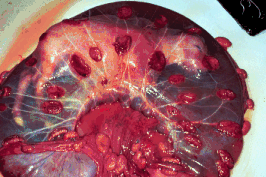 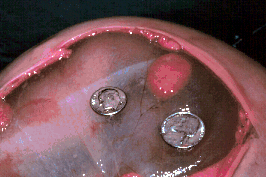
Placentomes (cotyledons on the placenta/caruncles on the uterus)
amniotic vesicle (AV)

Click here and right click on the first frame to
see a video on AV and FMS palpation.
fetal membrane slip (FMS) (chorioallantois)

Click here and right click on the first frame to
see a video on a dissected AV and FMS palpation.
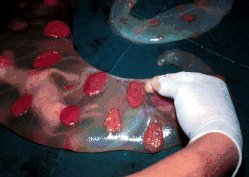
Technique of pregnancy diagnosis by
rectal palpation of a retractable uterus 
RETRACT, RETRACT, RETRACT !!!!!
You must retract the
uterus to fully and accurately.

Click here and then right click on the first frame
to see the retraction video.
First feel the uterus for asymmetry. At 35 days of
pregnancy the pregnant horn will feel slightly larger.
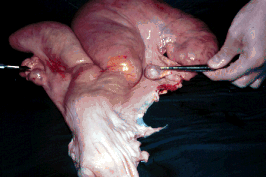
Asymmetry of the horns. Quite a bit actually.
Note the CL3 on ovary ipsilateral to the pregnancy.
Second, feel for fluid in the larger horn. The fluid
has a smooth velvety feel because the uterine wall thins during
pregnancy. The fluid almost feels like a water balloon that is not
totally full.
Third, You must systematically feel the
uterus for the amniotic vesicle, the fetal membrane slip, or the fetus.
(cotyledons will not appear until about 75 days). Although
the CL3 is on the ipsilateral ovary 99.9 % of the time and it may help
to identify the pregnant horn, it is not
a positive sign of pregnancy. Always follow
the golden rules of pregnancy diagnosis.
Technique for pregnancy diagnosis by
rectal palpation of a non retractable uterus Try
hard to retract the uterus and examine the entire tract. Try to slip
anterior to the cervix and feel for a fetus or cotyledons/caruncles.
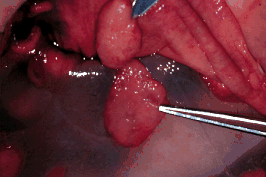
A cotyledon being peeled of a caruncle.
Other signs suggestive
of pregnancy are fremitus, which is a hypertrophy of middle uterine
artery. The middle uterine artery can be picked up in the broad ligament
and moved around. There is a fluid turbulence that gives a 'buzz'
feeling to the artery. You must rule out the external iliac.
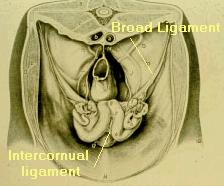
The middle uterine artery is in the broad ligament and movable.
Do not confuse with the iliac artery, which is not moveable.
If there is no corpus luteum present, the cow cannot
be pregnant. How good are we at determining the presence of a corpus
luteum?
Estimation of stage of pregnancy by
rectal palpation
Why do you need to
estimate the stage of pregnancy?
- There may be
lost records and you need to predict dry off dates.
- You
may need to stage pregnancy if records are not kept or a bull runs with
the herd.
- You may need to confirm AI dates, or
an AI date may not match what you feel.
- You may be asked to estimate
parturition dates for beef herds.
Technique: Fluid
is barely palpable at 28 days, although
this is not a positive sign of pregnancy. Amniotic
Vesicle (this is not recommend for student
palpation) The
AV can be palpated as long as 2 weeks
after is crushed. This would be a case where you find a positive sign of
pregnancy, but the cow is not pregnant.
| Days Gestation |
Width in mm |
Width in fingers |
| 35 |
7 |
1/2 |
| 42 |
15 |
1 |
| 48 |
35 |
2 |
| 52 |
55 |
3 |
| 58 |
75 |
4 |
| 62 |
90 |
4+ |
| 65 |
105 |
5 (can feel the fetus through the AV) |
Fetal Membrane Slip
(be gentle, as you can damage a pregnancy by rough palpation)
32 days thread 1 horn
45 small string 1horn
60 string 2 horns
>70 large string
Cotyledons (actually the placentome, which is the
cotyledon/caruncle unit). You must rule out that you a not palpating an
ovary by feeling at least 3.
75 days pea size
100 dime
115 nickel
125 quarter
150 half dollar
> 150 variable
Fetus
The fetus descends out of reach from 3-7 months.
You can first feel the fetus at 55-60 days inside the
AV.
To estimate an aborted fetus they are:
2 months mouse
3 months rat
4 months small cat
5 months large cat
6 months beagle dog
Fremitus
Fremitus is not a positive sign of pregnancy, but can
help staging.
At 5 months the artery ipsilateral to the pregnancy
has fremitus.
At 6 months both the artery ipsilateral and
contralateral to the pregnancy have fremitus.
At 7 months both arteries are large with fremitus and
the fetus is ascending.
Differentials in Pregnancy Diagnosis by
rectal palpation
- Failure to retract and no
positive sign of pregnancy found can be caused by:
- Incompetence
- this will diminish as your skills increase.
- Failure
to be complete
- Adhesions
- Pyometra
-
Segmental aplasia
- Mummification
-
Maceration
- Lymphosarcoma
-
Granulosa cell tumor
Signs of problems in pregnancy noted with
rectal palpation
- Excess uterine tone,
- crowded cotyledons,
- decreased
fluid,
- relaxation of pelvic diaphragm,
- bloody
discharge,
- wrinkled FMS,
- gestation
you palpate is not equal to the breeding date you are given (this could
just be an error in the records though).
Summary of Rectal Palpation for Pregnancy
Diagnosis
- Establish the time you are
confident in diagnosing pregnancy by rectal palpation.
- Always
be systematic in your examination.
- Observe the
golden rules of pregnancy diagnosis by rectal palpation.
Ultrasound

- There
are different types of machines available.
- The most commonly used
machines today are B-mode real-time, meaning that they produce an
acoustic image in real time.
- The usually range from 3.5 - 7.5 MHz,
- With greater MHz you see more detail but
have less depth penetration.
- There is more depth penetration with lower
MHz, but less detail. It is always a tradeoff.
- These machines cost from $10-20,000.
External
- Older
external machines marketed by Animark and sold to farmers were 3.5 MHz
external M-mode machines.
- These machines claimed 97% accuracy, but in
fact they had many false positives pregnancy diagnoses.
- This was used to
the company's advantage by checking beef herds, where almost all the
cows were pregnant.
- Since the machines called almost all the cows
pregnant, and they in fact were pregnant, the numbers looked very good for the machine.
- In my experience
the machine was 0 % accurate when demonstrated by the company salesman.
-
These M-mode machines cannot estimate stage of gestation.
- In
order to really test a machine like this you need to test on it on a
herd were half the cows are pregnant. This would tell much better how
many false positives and false negatives the machine has.
Intrarectal
- Ginther
used a machine to diagnose pregnancy at 12-14 days post insemination,
but the average was 28 days.
- This was in a research setting, not a
clinical setting.
- He also found that of 8 pregnant, 2 cows had early
embryonic deaths.
- Intrarectal ultrasound is
hard to do at first, and slightly more time consuming than rectal
palpation, but is now much more common.
- Most people that do this
find that days 26-28 give about 100% accuracy and the fetal heartbeat can
be seen at 21 days.
- The gestational age can be approximated and the
fetal viability can usually be determined.
- Ultrasound
allows sexing of the fetus to be done at approximately 55-60 days of
gestation. You look for the genital tubercle. This technique takes some
time to learn.
- Ultrasound has many potential advantages over rectal
palpation, but at present the cost is prohibitive.
- Fetal sexing can be done at about 60 days of
gestation.
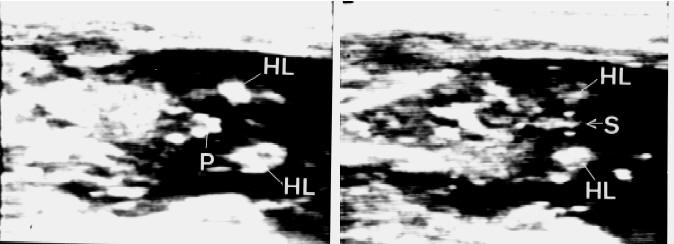
Ultrasound images
of a male fetus (68 days; frontal). Left shows
hindlimbs (HL) and penis (P). Right panel shows scrotum
(S).
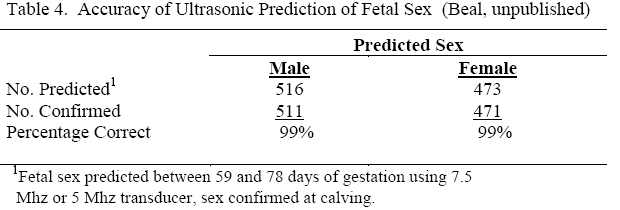
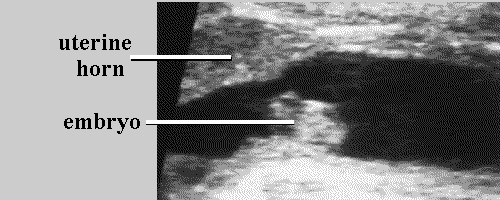
This is an image of a bovine conceptus and is identified as an
elongated, fluid filled structure occupying several coils of the
uterine horn.
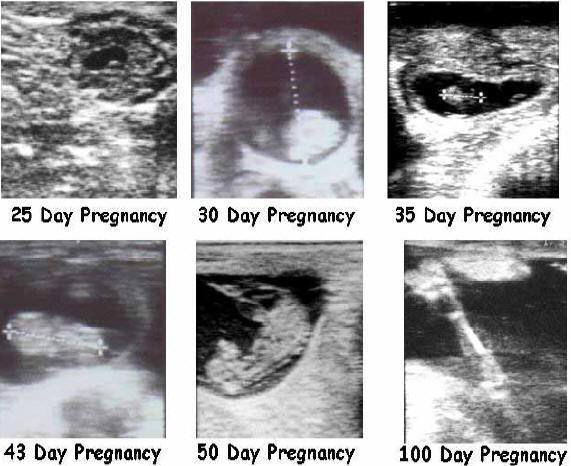
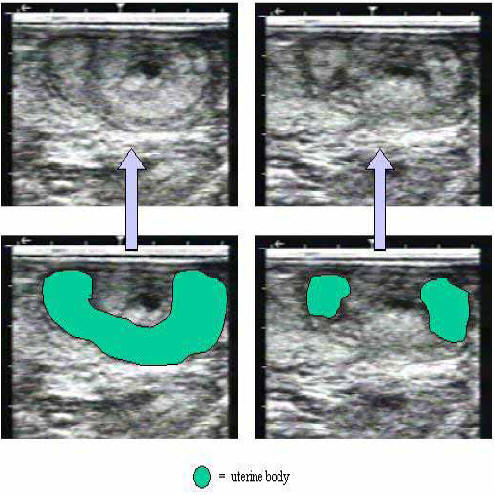
Ultrasound image depicting an elongated (left) and
cross-sectional (right)
view of the non-pregnant uterus.
- The bovine embryo will usually be located
in the uterine horn which is ipsilateral to the ovary containing
the corpus luteum and is first identifiable at 17-19 days of
gestation. The conceptal membranes expand to cover a large area
of the endometrium and thus initiate maternal recognition.
- Monitoring Pregnancy and Embryo
Development
- Real-time, B-mode ultrasonography has
been reported to detect pregnancy in
cattle as early as 9 (Boyd et al., 1988) or 12 days (Pierson
and Ginther, 1984) into gestation.
- Other reports, however, have disputed
those claims and emphasized that the
accuracy of ultrasound diagnosis of pregnancy on Day 10
through 16 is not significantly better than a random guess
(<50%).
- Accuracy of diagnoses improves,
however, by Day18 (85%), 20 (100%) and 22 (100%) of
pregnancy (Kastelic et al., 1989).
- The embryo proper is defined as a
distinct echogenic structure within the
nonechogenic, fluid-filled vesicle.
- Presence and vitality of the embryo
can be confirmed by the detection of a heartbeat as early as
19 to 24 days of gestation.
- The embryo initially appears as a
short, straight echoic line (Day 20-22), later becomes
C-shaped (Day 22-30), and finally, by Day 30-32 of
gestation assumes an L shape.
- Curran et al.(1986) characterized
the growth of the embryo proper from 20 through 60 days
of gestation, and determined when characteristics such
as the heartbeat (Day 22), spinal cord (Day 28),
placentomes (Day 35), split hooves (Day 44), and ribs
(Day 52) first became detectable. Subjective evaluation
of anatomical traits can be used to age bovine fetuses,
but the most accurate estimate of gestational age is
derived from actual measurements of specific features.
Milk progesterone assay

- This test is based on the milk
progesterone concentration 21-24 days post breeding.
- The milk
progesterone parallels blood progesterone.
- It is important to know that
this can only be used with known AI or breeding dates and the test
cannot be done randomly in a herd.
- It is based
on the fact that if progesterone is low 21 days postbreeding then there
is no chance that the cow can be pregnant.
- Remember that a cow must have
progesterone be pregnant. Therefore the test is 100% accurate at
non-pregnancy diagnosis when the progesterone is low.
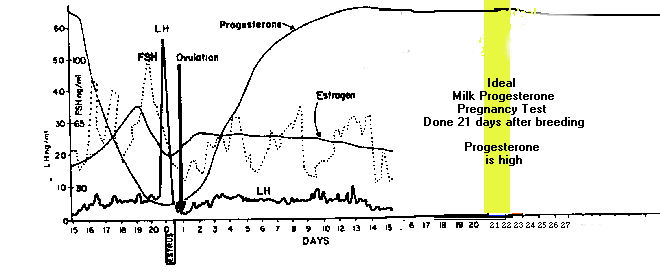
If Progesterone is high 21 days after breeding the cow 'should' be
pregnant.
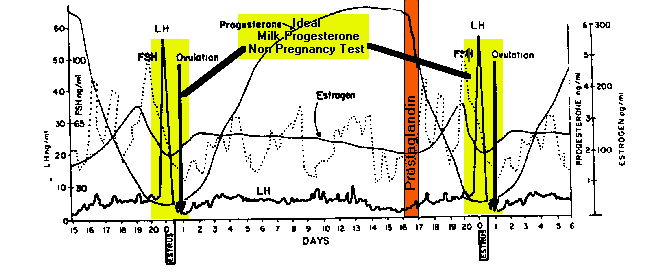
-
If Progesterone is low 21 days after breeding (or anytime) the cow
cannot be pregnant.
-
However, if the progesterone is high, the test is
only 80 % accurate at diagnosing cows pregnant.
-
This is because there
may be mistakes and cows may be bred that are not actually in heat. These
cows would therefore have high progesterone 21 days later, yet not be
pregnant.
-
Also cows with short and long cycles can cause
misinterpretation of the test.
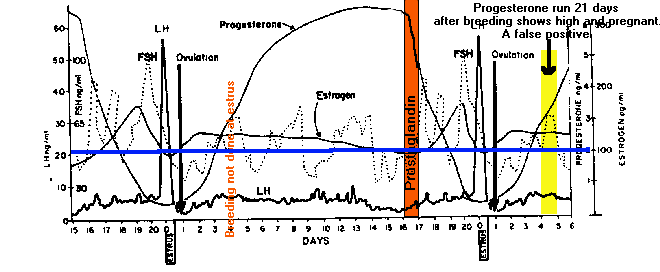
-
Note the chart above. A false positive if breeding was not done at
estrus. The progesterone 21 days later may be high and indicate a pregnant
cow. The blue line indicates the 2 ng/ml threshold value for positive.
-
At one time a 'cow side' test that cost $3-5/test was
marketed. Some other tests have also been marketed.
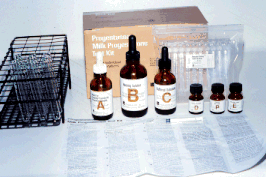
A 'cowside' milk progesterone test that is no longer marketed.
Protein
B (bovine pregnancy-specific protein B) (bPSB, bTP-1)
- Protein
B is secreted by trophoblast cells (binucleate giant cells).
- It
is a radioimmunoassy procedure, and therefore is time consuming and
relatively expensive.
- There are false
positives early in the post partum because it is present in the post
partum period.
- The first beef study was based
on data 30 days after bull removal.
- They found 99% accuracy on non
pregnant (3/102), 95% on pregnant ( 99/102) 30 days after bull removal.
-
Palpation found 98/102 pregnant and 4/102 open.
- In the end 98 cows
calved, which looks very good.....but this has only been published in a
lay journal and the palpation ability was unknown.
- Also the article did
not state which 98 cows actually calved. Was it the cows that the test
said were pregnant or were there false positives and negatives.
- A
study done in a dairy is shown below: The numbers
refer to the accuracy of the diagnosis.
| |
Day 24 |
Day 26 |
Day 30-35 |
| PSPB pregnant |
86% |
87% |
90% |
| PSPB open |
71% |
89% |
100% |
| Palpation pregnant |
not done |
not done |
99% |
| Palpation open |
not done |
not done |
100% |
-
These results show that PSPB is not much, if any,
better than palpation. Since you need an RIA, there will be a time delay
between samples and results. Also, you cannot age, sex, or determine
fetal viability. Needless to say, this
technique is not used by anyone I know of.
-
Click
here to link to a web page that sells the kits

- Cost is $1.67/cow (plus you have to bleed them and mail the
samples in and wait for results) - The site provides an
interesting calculator to determine how much you can save using
this over palpation. (note how much is credited for EED and
inaccuracy by rectal palpation)
- There are great claims by the company of the
advantages over palpation
- Cheaper
- More accurate
- No early embryonic deaths
- Critical evaluation tells us
- May be cheaper, depending on how you charge for
palpation
- You get just as many early embryonic deaths
- Not as fast - you cannot sort cows pregnant vs.
non-pregnant cows at the time of sampling - requires
handling the cows twice
- Cannot age the pregnancy
- Cannot detect pathology
Early
Pregnancy Factor
Check
this link out to a potentially exciting method to determine bovine
pregnancy.
- EPF - two components
- EPF-A - Uterine tube
- EPF -B - Ovary
- Production requires signal from fertilized ovum (ovum factor)
released under prolactin presence after sperm penetration.
- Appears 4-6 hours
- Disappears with fetal death
- Non-detectable at 20 days in milk and 30 days in serum
- Lateral flow dipstick test
- Cordoba MC, Sartori R, Fricke PM.
Assessment of a commercially available early conception factor (ECF)
test for determining pregnancy status of dairy cattle. J Dairy Sci.
84:1884-9, 2001.
- 17 non bred
- 18 Day 6 embryo flush cows
- Test sensitivity - 86%
- Specificity - 4%
- Positive predictive value - 49%
- Negative predictive value - 23%
- False-positive - 96%
- False-negative - 14%
- Table - data for 1
test by 1 tester (above is composite
information)
| Test |
Preg |
Non |
Totals |
|
| + |
- |
|
|
| Pregnant |
16 |
16 |
32 |
50% PPV |
| Non-Pregnant |
2 |
1 |
3 |
33% NPV |
| Totals |
18 |
17 |
|
|
| |
89% Sens |
6% Spec |
|
|
- Conclude that the ECF test is an unreliable
method for determining pregnancy status of dairy cattle on day 6
after estrus.
|
 Bovine
Index
Bovine
Index



















